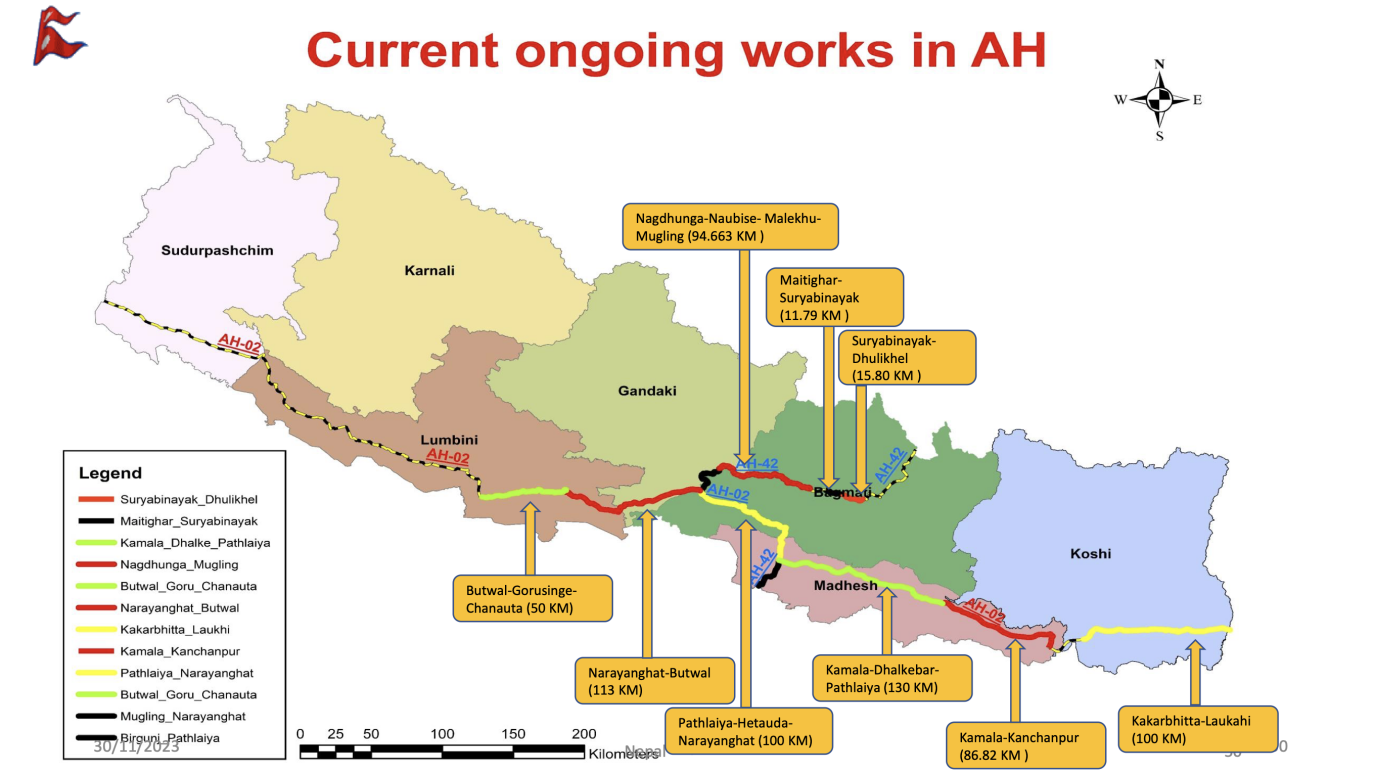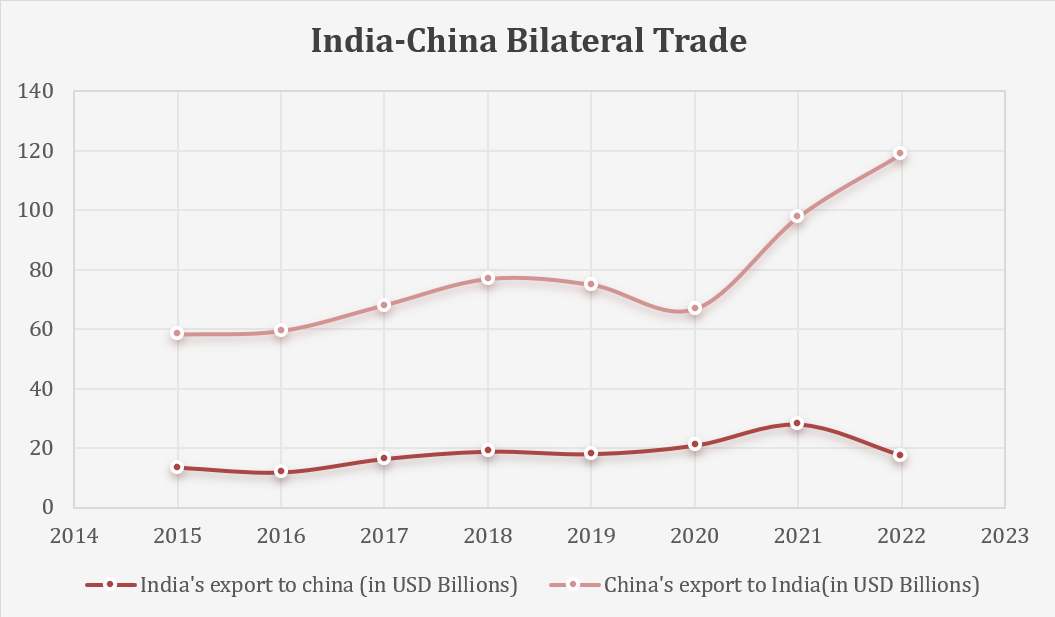Introduction
The Asian Highway, spanning over the Asian continent, with a length of more than 140,000 km, stretches across 32 out of 49 countries of Asia. The highway aims to build a road network connecting various countries by building highways where necessary, using existing roads that meet the highway criteria, and improving roads that do not meet the minimum standards. While the idea of this cross-country road network is a long-held project which dates to the 1950s, it is only recently that it gained momentum. Today, it is a cooperative project carried out jointly by various Asian countries through the United Nations Economic and Social Commission for Asia and the Pacific (ESCAP) under the Asian Land Transport Infrastructure Development (ALTID) project. The larger chunk of funds have been provided by larger Asian economies such as China, Japan, Singapore, South Korea and international agencies such as the Asian Development Bank (ADB) and the Asian Infrastructure Investment Bank (AIIB). The highway passes through most Asian countries but Middle Eastern nations like Saudi Arabia, UAE, Oman, and Iraq are not part of the arrangement yet.
Figure 1. Timeline of the Asian Highway Project
Source: UNESCAP
The Asian Highway Progress in Nepal
Nepal became a part of the Asian Highway when the Vice-Chairman of the National Planning Commission, Dr. Shankar Prasad Sharma signed an agreement for the operation of the Asian Highway at the Sanghai Convention on April 28, 2004.
In Nepal, Asian Highway-02 (AH-02) overlaps the existing Mahendra Highway from Mechi to Mahakali, with a length of 1027 kms, which then merges with AH-01 at Delhi. The other part of the Asian Highway that passes through Nepal, stretching for 297 kms, is AH-42 that runs from Kodari in the North to Birgunj in the South via Kathmandu. This highway overlaps with the existing Araniko Highway, merges with AH-02 at Narayangarh, runs eastward and bifurcates at Pathlaiya to head towards Birgunj in the South. The AH-42 then crosses the border again to merge with AH-01 at BarhiJharkhand, India.
There are various agencies that are funding Nepal to build the Asian Highway. Besides the Government of Nepal, World Bank and the Asian Development Bank (ADB) are funding road improvement from two-lane to four-lane or six-lane highways. Japanese International Cooperation Agency (JICA) is also providing funds for tunnel construction and intersection improvement. Similarly, the People’s Republic of China is funding the maintenance of roads, slope stabilization, and emergency works. Further details on the projects and their funding agencies are presented on the table below:
Table 2. Status of Nepali Asian Highway Projects
| Projects | Funding Agencies | Remarks |
| Strategic Road Connectivity and Trade Improvement Project (SRCTIP) | World Bank | |
| Improvement of the Existing Nagdhunga-Naubise-Malekhu-Mugling road to two-lane standard: 94.66 km (AH-42) | Under construction | |
| Upgrading of Kamala-Dhalkebar-Pathaliya road from two-lane to four-lane: 130 km (AH-02) | Bid Preparation | |
| Accelerating Transport and Trade Connectivity in Eastern South Asia Nepal Phase-I Project (ACCESS) | World Bank | |
| Butwal-Gorusinge-Chaunata Road: 50 km (AH-02) | Bid Preparation | |
| Tinau Bridge (Green Resilient Urban Bridge) (AH-02) | Bid Preparation | |
| South Asian Subregional Economic Cooperation SASEC Roads Improvement Project (SRIP) | ADB | |
| Upgrading of Narayanghat-Butwal road from two-lane to four-lane: 113 km (AH-02) | Under Construction | |
| SASEC Highway Enhancement Project (SHEP) | ADB | |
| Upgrading of Kakarvitta-Laukahi from two-lane to four-lane: 113 km (AH-02) | Under Construction | |
| SASEC Highway Improvement Project (SHIP) | ADB | |
| Upgrading of Kamala-Kanchanpur road from two-lane to four-lane: 86.82 km (AH-02) | 25% of physical progress | |
| Pathlaiya-Hetauda-Narayanghat: 100 km (AH-02) | Design Ongoing | |
| Butwal-Gorusinghe-Chhanauta: 50 Km (Ah-02) | Design Completed | |
| Nagdhunga Tunnel Construction Project (AH-42) | JICA | Under Construction |
| Tinkune-Koteshwor Jadibuti Intersection Project (AH-42) | JICA | Pre-feasibility study |
| Araniko Highway Maintenance Project Phase II (AH-42) | China | Maintenance activities on different chainage |
Source: UNESCAP
Figure 2. Current Ongoing Works of the Asian Highway in Nepal
Source: UNESCAP
Why the Asian Highway is Important for Nepal
Nepal, as a land-locked country, has relied on road infrastructure for trade and transport since the beginning of time. There was only one highway that connected the East from the West before the ongoing construction of the mid-hill highway. But there are plenty of highways that connect different corners of Nepal vertically that sprout like branches from East-West Highway. The long-standing East-West Highway is the backbone of the Nepali road infrastructure while waterways, airways, and rope-ways still have a long way to go forward. Thus, these networks of the Asian Highway can play an instrumental role to transform Nepal from a land-locked to a land-linked nation.
AH-02 and AH-42 not only improve the condition of road infrastructure in Nepal, they also provide Nepal with an increased access to other countries for trade and tourism. These routes connect the world’s largest, most populated, and emerging economies. As China and India are, respectively, the world’s largest and third largest economies, the trade between them is soaring, as illustrated in the figure below. Thus, through the highways, Nepal can take advantage of this to leverage its strategic location and provide access to Chinese as well as Indians for trade routes. Furthermore, AH-42 can be the alternative as well as the shortest route for the goods that otherwise has to pass through strait of Malacca.
Figure 3. India-China Bilateral Trade
Source: Embassy of India, China
The Asian Highway, that can connect Asia to Europe, can revitalize the old hippie trail that once brought tourists during 1950s to 1970s from across the European continent to Nepal. Nepal can also increase the volume of tourists coming from India, Bangladesh and other neighboring nations. AH-02 also provides higher access to south-east Asian countries like Myanmar, Vietnam, Thailand etc which are predominantly Buddhist which Nepal, as a birthplace of lord Buddha, can attract a lot of tourists from.
What Are the Bottlenecks?
While the Asian Highway has the potential to boost Asian economies, it will not be easy for Asian economies to replicate the European model of economic integration and achieve their level of affluence. Asian economies have huge variations among them despite sharing the same borderlines and face various issues. Further, there are multiple ongoing political tensions in countries such as Bangladesh and Myanmar and the threat of war between countries like India and Pakistan that can hinder the progress needed for the development of the highway. Meanwhile, countries like Afghanistan and North Korea, with isolationist policies, can further hinder the process of integration. Besides this, problems with natural disasters can also cause major obstacles in fully realizing the potential of the Asian Highway.
Conclusion
Nepal has always viewed itself as a victim of land-locked-ness but the Asian highway can provide us an opportunity to act as a bridge and connect two largest economies of the 21st century as well as connect Asia with Europe. However, since economies cannot flourish amidst political instability and in the state of war, to realize integrated and prosperous Asia, all nations should resolve the conflicts within themselves as well as other countries to facilitate trade and commerce across the continent, for richer and better future of the continent.
Sujal Budhathoki is an intern at Nepal Economic Forum. He has completed his Bachelor of Business Administration from Tribhuvan University, specializing in Banking and Finance. He has previously interned at NIC Asia Bank Limited. His interests lie in the field of management consulting, economic policy and sustainability.








